SEO
7 Lessons to 1 Million Monthly Visits
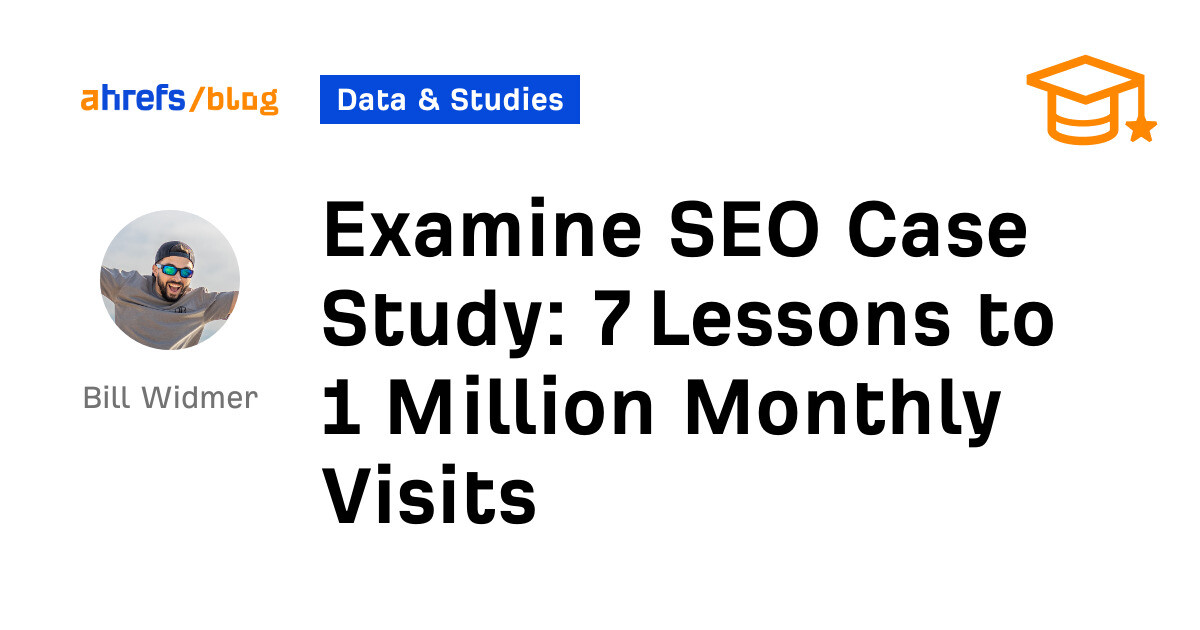
Examine.com was able to reach over 1 million monthly visitors from Google search results. The best part? It did so without any manual backlink outreach or even having a focus on SEO.

That’s not all. Despite not using outreach, it acquired links from sites like The New York Times and Forbes—on autopilot.
How? I spoke with the co-founder, Sol Orwell, to find out.
He shared the site’s entire approach to SEO with me, including how it recovered from a 90% traffic drop and how the business grew to over 30 employees. Here are a few lessons learned from a multimillion-dollar company.
Examine provides evidence-based analysis of supplements and nutrition through its team of researchers with varying backgrounds, including PhDs in physiology, neurobiology, nutrition, and more.

It makes money by selling a subscription service that gives you access to its in-depth research on health conditions and goals. So if you want to learn how to improve osteoarthritis, for example, you can access the most actionable and up-to-date research that exists online.
If you were paying attention, you’d notice I already revealed some of Examine’s SEO secrets. But let me break down the seven specific SEO lessons you can learn from it:
Examine has received dozens of extremely high-quality links from The Guardian. How? Sol attributes it to a by-product of caring about people.
He met someone years before they ever got a link, and that person happened to make a connection with a writer for The Guardian and mention Examine to them—the writer loved what they saw and now regularly links to them in their articles.

Of course, Examine also needed to have content worthy of receiving these links. Relationships alone won’t build links for you, at least not the best links.
But how can you build relationships that lead to backlinks?
Mostly from meeting and assisting as many people as possible. One of the best ways to do that is by going to in-person meetups and events. But if that’s not possible, being active in forums and online communities is also a great option.
Check out these online marketing communities to get started. Just remember—you’re trying to build genuine relationships, not just manipulate people into linking to your website. Be helpful and give without expecting anything in return.
This is where Examine truly shines. It summarizes over 150 studies every month with key findings and actionable takeaways.
Unique data is one of the best ways to capture extremely high-quality backlinks.
For example, Examine’s research page on L-theanine contains all of its findings about L-theanine’s effects on the body in a single, easy-to-digest page with unique data.

This page has attracted over 1,000 backlinks. Some of these links are from strong sites like Psychology Today and The Huffington Post and were acquired organically without outreach.
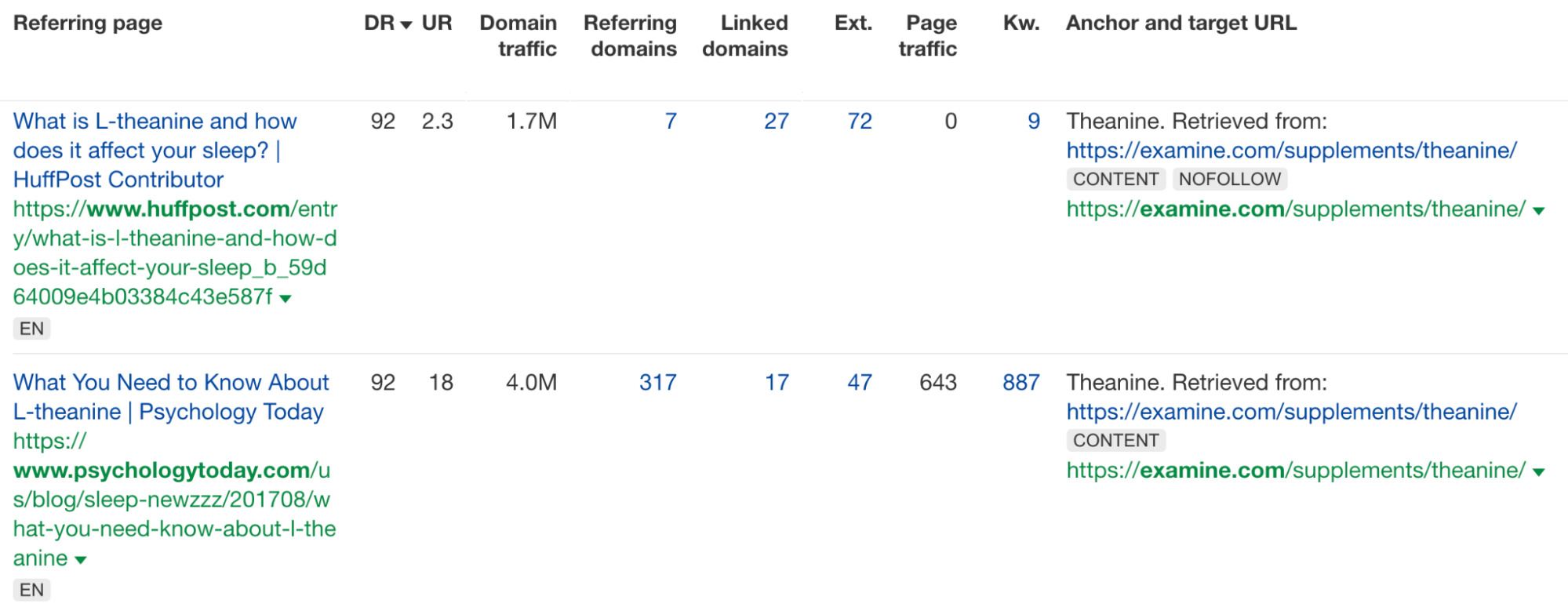
Don’t worry—you don’t need to create 150 study summaries every month to use this strategy. Instead, just a few targeted statistics summary pages can do the trick.
For example, we created a summary of SEO statistics. It ranks #1 on Google for keywords like “seo statistics” and has accumulated nearly 4,000 backlinks.
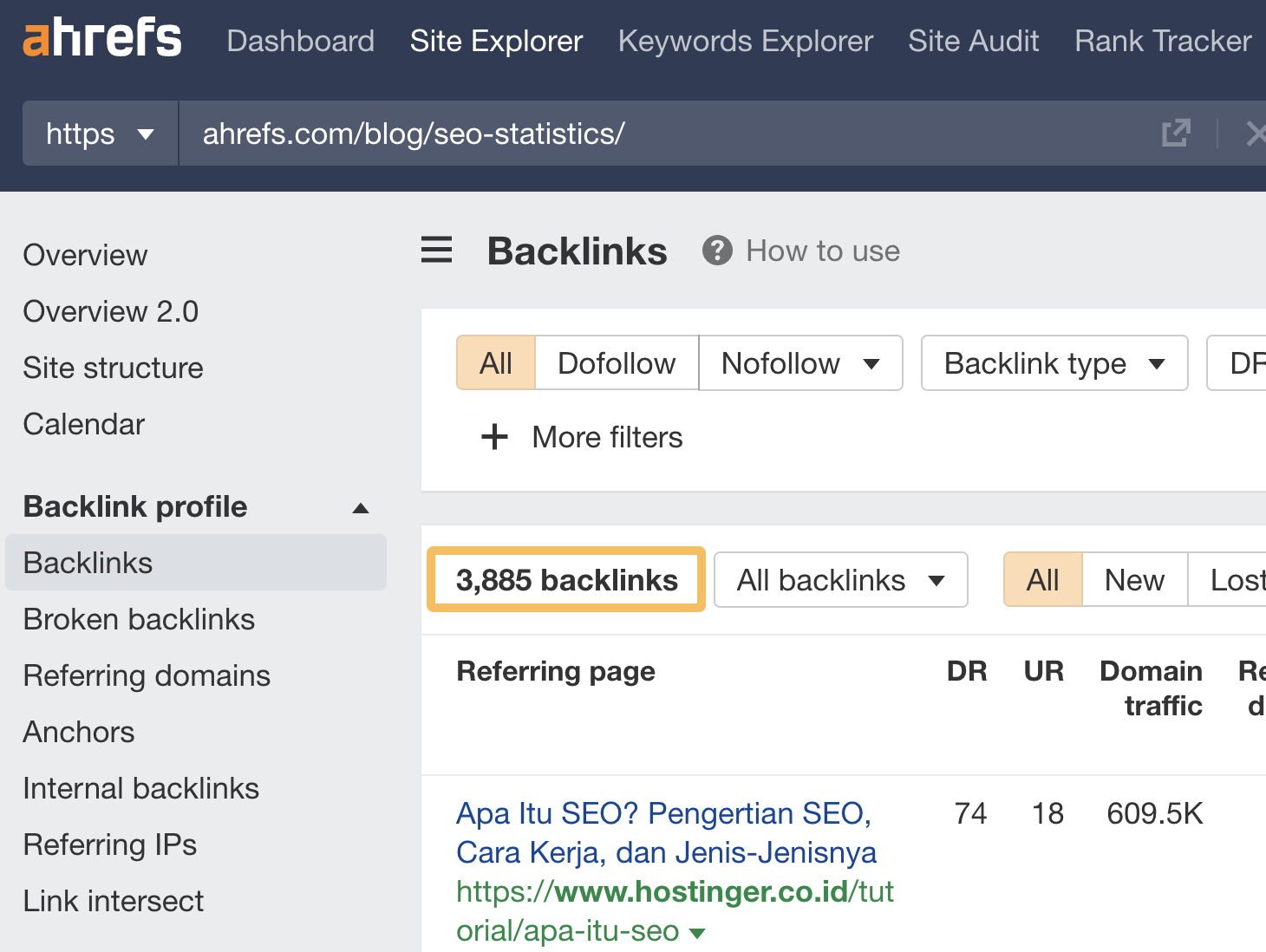
Want to learn how we did it? Check out our full case study.
In addition to incredibly strong backlinks, Examine regularly receives mentions on the “Huberman Lab” podcast—one of the most renowned science and health podcasts in the world.
This is because it publishes ridiculously good content.
So what’s its secret?
Well, it lays out its exact content creation process on its editorial policy page:
- Researcher and reviewer create outline to fully address the question/topic at hand
- Researcher writes the article
- Article is copyedited by content editor
- Article is edited by editor
- Article is reviewed by reviewer
- Corrections and clarifications are incorporated at every level
- Article is published on the website
It also discusses how it minimizes bias.
All in all, it has several layers of edits and reviews for each piece of content that’s published on the site.
More importantly, these reviews are done by “a diverse team of researchers who fully read all relevant scientific papers completely and have no conflicts of interest.”
This rigorous process is expensive and time consuming, but it has to be in the health and science space. More lax spaces can get away with much less scrutiny, but you still need to do the work to ensure your content is top-tier.
Here are some ways to make your content better:
- Create content outlines for your articles before you write them
- Do extensive research and give your articles at least one “editorial pass-over”
- Back up your claims with evidence where possible
- Read up on how to become a better writer—and practice every day
- Invest in graphic design, photography, and/or video to enhance your content with media
It may also be worth hiring an editor if you don’t already have one. You can find one on job sites like Indeed or on service sites like Fiverr.
I mentioned earlier that Examine never focused on SEO as part of its strategy.
Yes, it optimized its headings and added schema markup—but it never did extensive keyword research or wrote articles specifically to rank on Google.
Instead, it focused on providing the best possible experience for its customers. This is highlighted in a story Sol told me about his company:
One of Examine’s employees was on her way home from a company retreat. The Uber driver was feeling chatty and asked her the typical question, “What do you do for work?”
When the employee answered, the Uber driver proceeded to pull over and bawl her eyes out.
Apparently, the driver’s chronic health conditions had got so bad that she could no longer work. But Examine’s evidence-based information helped her deal with her health conditions to the point where she felt well enough to work again, allowing her to give that very Uber ride.
She told the employee she was so grateful for Examine and that it changed her life.
Experiences like these with companies are exceedingly rare in a profit-driven, cut-throat world. But what does this have to do with SEO?
It comes back to building a strong brand and a company that people love.
One of the reasons this is important is because it increases your search visibility, i.e., the percentage of people who click on your search result when they see it. This is one of the most important SEO metrics to track because the higher your search visibility, the more people value your result over competing results.
If people know who you are and love your brand, they’re more likely to click on your result over a competitor’s. Speaking of branding, let’s move on to…
Examine was hit with a major traffic loss after a 2018 Google core update related to E-A-T.
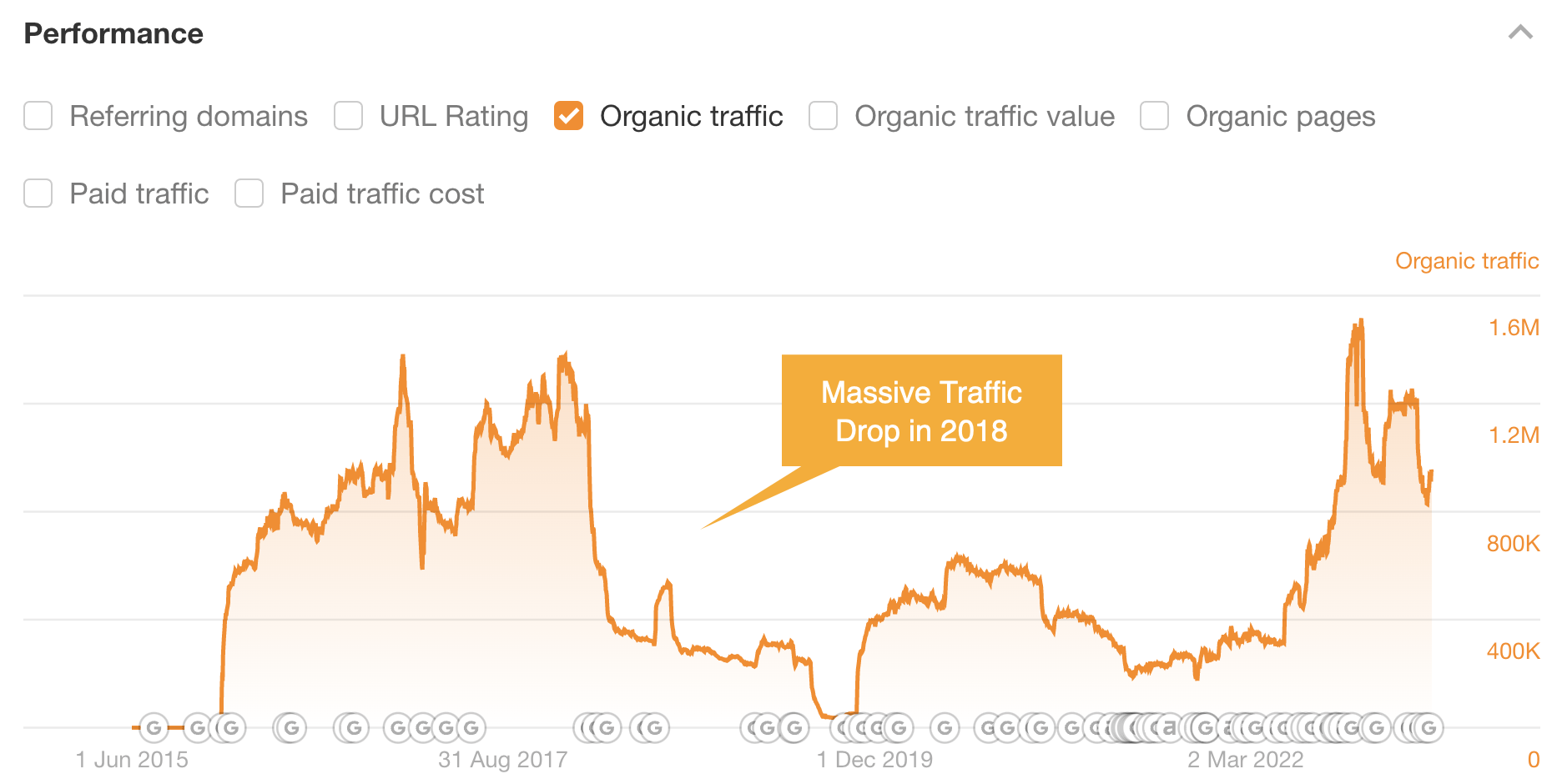
After the algorithm hit, 90% of its traffic came from branded searches, such as “examine.com creatine.” This means these people are searching specifically for resources from Examine’s brand as opposed to other websites.

In fact, it was receiving almost 4,000 visits per day from these branded search terms. This is important because even if your site loses on an algorithm update, you will still retain your rankings for branded terms.
But how did it manage to get a “cult following” of people who specifically want to search for its brand? By focusing on the other things I mention in this case study:
- Provide an amazing customer experience
- Create the best content in the world
- Build strong relationships
There’s, unfortunately, no shortcut for hard work in this case.
As mentioned above, Examine lost the majority of its traffic back in 2018 to a Google update related to E-A-T (now E-E-A-T, or experience, expertise, authoritativeness, and trustworthiness).
In other words, Google only wants to display content that is written by people who actually have the qualifications to write about a given topic.
When Examine relaunched the website, it wanted to be more trustworthy. Here’s how it did that:
1. It added a section above the fold of each article showing exactly who took part in researching and fact-checking said article.

2. It deeply expanded its “about” page to add bios for everyone in its company, an explanation of how it is funded, and a section on why you can trust it.
3. It created an “editorial policy” page showing exactly how its team researches, writes, and edits each article before publishing.
Essentially, it is as transparent as possible about where the information is from, who found the information, and why they are qualified to write about that information. This transparency helped the site recover its traffic to the tune of over 1 million visits per month.
The takeaway here for you is that you should have experience or expertise in a given topic in order to write about it and be displayed on Google. You should also effectively demonstrate E-E-A-T on your website, as Examine did in its relaunch.
That means:
- Use the products you’re reviewing
- Go to the places you’re talking about
- Speak with real experts if you aren’t one
- Create an “about” page and “editorial policy” page showcasing why people should trust you
While Examine never focused on SEO as a main strategy, it wasn’t oblivious to it either. It runs twice-a-year SEO audits on its site to ensure it’s not missing simple things.
Its SEO audit consists of asking questions like:
- Are there any orphaned pages?
- Are there dead links?
- Are there pages covering the most frequently asked questions from its users?
You can quickly and easily run an SEO audit like this on your own site with Ahrefs’ Site Audit. Just plug your site in, and you’ll get actionable advice on how to fix any issue:
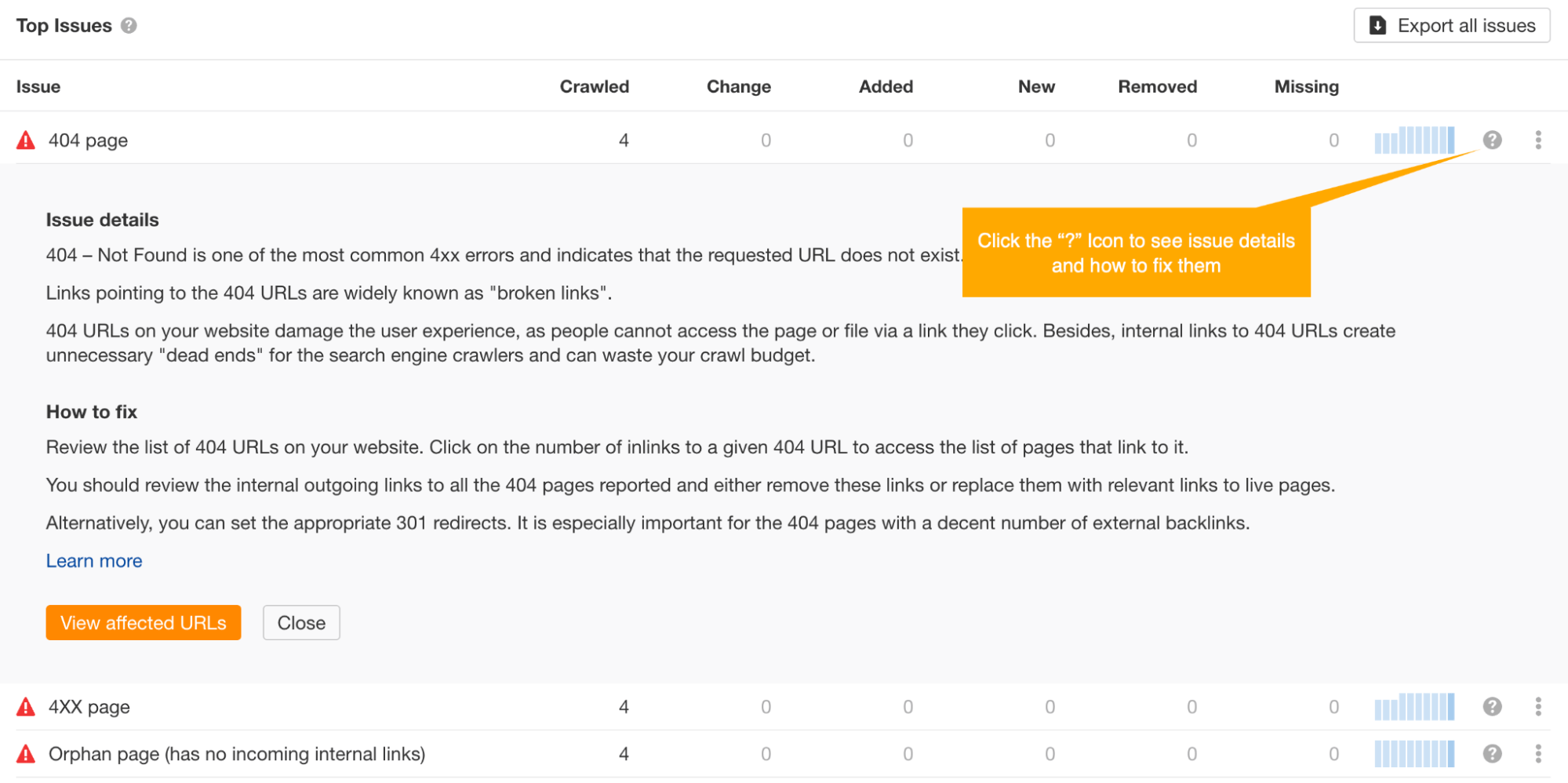
From here, it’s easy to find and fix all the SEO issues on your website. Go through and fix each one to improve your odds of ranking highly.
If you don’t understand an issue, it may be worth hiring a developer to help you make the fix.
Final thoughts
There are a lot of reasons Examine has been so successful. But if I had to narrow down to just three that you could replicate, they would be the following:
- Create world-class content by spending time becoming a better researcher and writer and consider hiring people to help you, such as an editor
- Build quality relationships with other professionals in your industry by offering to help them with no expectation of getting anything in return
- Become an expert in your field through research and experience, and create an “about” page showcasing why people should trust you and your website
Sol told me he attributes most of Examine’s success to being an extremely high-quality resource for journalists, doctors and, most importantly, customers.
This level of trust isn’t easily won, but it can be done. I’ve outlined everything you need to do to achieve it in the lessons above.
SEO
Google Declares It The “Gemini Era” As Revenue Grows 15%

Alphabet Inc., Google’s parent company, announced its first quarter 2024 financial results today.
While Google reported double-digit growth in key revenue areas, the focus was on its AI developments, dubbed the “Gemini era” by CEO Sundar Pichai.
The Numbers: 15% Revenue Growth, Operating Margins Expand
Alphabet reported Q1 revenues of $80.5 billion, a 15% increase year-over-year, exceeding Wall Street’s projections.
Net income was $23.7 billion, with diluted earnings per share of $1.89. Operating margins expanded to 32%, up from 25% in the prior year.
Ruth Porat, Alphabet’s President and CFO, stated:
“Our strong financial results reflect revenue strength across the company and ongoing efforts to durably reengineer our cost base.”
Google’s core advertising units, such as Search and YouTube, drove growth. Google advertising revenues hit $61.7 billion for the quarter.
The Cloud division also maintained momentum, with revenues of $9.6 billion, up 28% year-over-year.
Pichai highlighted that YouTube and Cloud are expected to exit 2024 at a combined $100 billion annual revenue run rate.
Generative AI Integration in Search
Google experimented with AI-powered features in Search Labs before recently introducing AI overviews into the main search results page.
Regarding the gradual rollout, Pichai states:
“We are being measured in how we do this, focusing on areas where gen AI can improve the Search experience, while also prioritizing traffic to websites and merchants.”
Pichai reports that Google’s generative AI features have answered over a billion queries already:
“We’ve already served billions of queries with our generative AI features. It’s enabling people to access new information, to ask questions in new ways, and to ask more complex questions.”
Google reports increased Search usage and user satisfaction among those interacting with the new AI overview results.
The company also highlighted its “Circle to Search” feature on Android, which allows users to circle objects on their screen or in videos to get instant AI-powered answers via Google Lens.
Reorganizing For The “Gemini Era”
As part of the AI roadmap, Alphabet is consolidating all teams building AI models under the Google DeepMind umbrella.
Pichai revealed that, through hardware and software improvements, the company has reduced machine costs associated with its generative AI search results by 80% over the past year.
He states:
“Our data centers are some of the most high-performing, secure, reliable and efficient in the world. We’ve developed new AI models and algorithms that are more than one hundred times more efficient than they were 18 months ago.
How Will Google Make Money With AI?
Alphabet sees opportunities to monetize AI through its advertising products, Cloud offerings, and subscription services.
Google is integrating Gemini into ad products like Performance Max. The company’s Cloud division is bringing “the best of Google AI” to enterprise customers worldwide.
Google One, the company’s subscription service, surpassed 100 million paid subscribers in Q1 and introduced a new premium plan featuring advanced generative AI capabilities powered by Gemini models.
Future Outlook
Pichai outlined six key advantages positioning Alphabet to lead the “next wave of AI innovation”:
- Research leadership in AI breakthroughs like the multimodal Gemini model
- Robust AI infrastructure and custom TPU chips
- Integrating generative AI into Search to enhance the user experience
- A global product footprint reaching billions
- Streamlined teams and improved execution velocity
- Multiple revenue streams to monetize AI through advertising and cloud
With upcoming events like Google I/O and Google Marketing Live, the company is expected to share further updates on its AI initiatives and product roadmap.
Featured Image: Sergei Elagin/Shutterstock
SEO
brightonSEO Live Blog

Hello everyone. It’s April again, so I’m back in Brighton for another two days of Being the introvert I am, my idea of fun isn’t hanging around our booth all day explaining we’ve run out of t-shirts (seriously, you need to be fast if you want swag!). So I decided to do something useful and live-blog the event instead.
Follow below for talk takeaways and (very) mildly humorous commentary. sun, sea, and SEO!
SEO
Google Further Postpones Third-Party Cookie Deprecation In Chrome

Google has again delayed its plan to phase out third-party cookies in the Chrome web browser. The latest postponement comes after ongoing challenges in reconciling feedback from industry stakeholders and regulators.
The announcement was made in Google and the UK’s Competition and Markets Authority (CMA) joint quarterly report on the Privacy Sandbox initiative, scheduled for release on April 26.
Chrome’s Third-Party Cookie Phaseout Pushed To 2025
Google states it “will not complete third-party cookie deprecation during the second half of Q4” this year as planned.
Instead, the tech giant aims to begin deprecating third-party cookies in Chrome “starting early next year,” assuming an agreement can be reached with the CMA and the UK’s Information Commissioner’s Office (ICO).
The statement reads:
“We recognize that there are ongoing challenges related to reconciling divergent feedback from the industry, regulators and developers, and will continue to engage closely with the entire ecosystem. It’s also critical that the CMA has sufficient time to review all evidence, including results from industry tests, which the CMA has asked market participants to provide by the end of June.”
Continued Engagement With Regulators
Google reiterated its commitment to “engaging closely with the CMA and ICO” throughout the process and hopes to conclude discussions this year.
This marks the third delay to Google’s plan to deprecate third-party cookies, initially aiming for a Q3 2023 phaseout before pushing it back to late 2024.
The postponements reflect the challenges in transitioning away from cross-site user tracking while balancing privacy and advertiser interests.
Transition Period & Impact
In January, Chrome began restricting third-party cookie access for 1% of users globally. This percentage was expected to gradually increase until 100% of users were covered by Q3 2024.
However, the latest delay gives websites and services more time to migrate away from third-party cookie dependencies through Google’s limited “deprecation trials” program.
The trials offer temporary cookie access extensions until December 27, 2024, for non-advertising use cases that can demonstrate direct user impact and functional breakage.
While easing the transition, the trials have strict eligibility rules. Advertising-related services are ineligible, and origins matching known ad-related domains are rejected.
Google states the program aims to address functional issues rather than relieve general data collection inconveniences.
Publisher & Advertiser Implications
The repeated delays highlight the potential disruption for digital publishers and advertisers relying on third-party cookie tracking.
Industry groups have raised concerns that restricting cross-site tracking could push websites toward more opaque privacy-invasive practices.
However, privacy advocates view the phaseout as crucial in preventing covert user profiling across the web.
With the latest postponement, all parties have more time to prepare for the eventual loss of third-party cookies and adopt Google’s proposed Privacy Sandbox APIs as replacements.
Featured Image: Novikov Aleksey/Shutterstock
-

 PPC7 days ago
PPC7 days ago19 Best SEO Tools in 2024 (For Every Use Case)
-
SEARCHENGINES6 days ago
Daily Search Forum Recap: April 19, 2024
-

 WORDPRESS7 days ago
WORDPRESS7 days agoHow to Make $5000 of Passive Income Every Month in WordPress
-

 WORDPRESS5 days ago
WORDPRESS5 days ago13 Best HubSpot Alternatives for 2024 (Free + Paid)
-

 MARKETING6 days ago
MARKETING6 days agoBattling for Attention in the 2024 Election Year Media Frenzy
-

 SEO7 days ago
SEO7 days ago25 WordPress Alternatives Best For SEO
-

 WORDPRESS6 days ago
WORDPRESS6 days ago7 Best WooCommerce Points and Rewards Plugins (Free & Paid)
-

 AFFILIATE MARKETING7 days ago
AFFILIATE MARKETING7 days agoAI Will Transform the Workplace. Here’s How HR Can Prepare for It.















